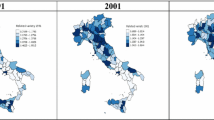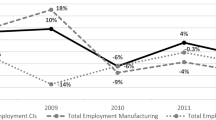Abstract
Spain is one of the European countries that have been strongly hit by the 2008–2009 economic and financial crisis. During the expansion period (2000–2007), the strength of GDP growth stemmed from an important increase in the country’s real estate sector. However, this model proved to be highly unsustainable after 2007 when the rise in unemployment rates and the decrease in GDP growth contributed to one of the toughest economic periods in the country’s history. The need to foster alternatives to the existing economic structure has become evident in Spain, even more so in cities and regions, particularly those concentrating a high percentage of economic activity. Creative and knowledge sectors have been the target of many programmes and policies since the crisis, some focusing on existing traditions and pathways, others targeting completely new and emergent specialisations. This chapter will analyse the economic performance of four city-regions in Spain, namely, Barcelona, Bilbao, Madrid, and Valencia, in terms of the significance of creative and knowledge sectors for their economies. A fundamental question drives our research: To what extent are these new patterns of economic growth, based on creativity and knowledge, able to compensate for the economic downturn in terms of unemployment and economic development in Spain? In order to answer this, a three-axis model (actors, pathways, and policies) will underpin the analysis of creative- and knowledge-based examples in the four city-regions selected, considering three different categories: bottom-up, top-down, and bottom-linked. The chapter uses secondary data for aggregate economic indicators in addition to qualitative data such as interviews with relevant actors, including policy-makers and representatives of creative and knowledge company workers and managers in the four city-regions considered.
Access this chapter
Tax calculation will be finalised at checkout
Purchases are for personal use only
Similar content being viewed by others
Notes
- 1.
The UK’s definition of the creative industries (‘those industries that are based on individual creativity, skill and talent with the potential to create wealth and jobs through developing intellectual property’) includes 13 sectors: advertising, architecture, the art and antiques market, crafts, design, designer fashion, film, interactive leisure software (i.e. video games), music, the performing arts, publishing, software, and television and radio.
- 2.
Defining creative and knowledge sectors: creative industries – publishing, architecture, arts/antiques trade, designer fashion, video, film, music and photography, music and the visual and performing arts, advertising, computer games, software and electronic publishing, radio and television; knowledge-based industries – information and communication technology, finance, law and other business services, R&D and higher education.
- 3.
Due to methodological problems (lack of available data for city-regions), data used in this section refer to the Autonomous Communities (A.C.) (Catalonia, the Basque Country, Madrid, and Valencia), our four case studies being their capitals.
- 4.
Valencia was conquered by the Aragonese crown and repopulated by Catalans in the Middle Ages, remaining part of the Aragonese Kingdom until its integration into the Spanish state.
- 5.
We refer here to the tourism industry and the celebration of events and meetings that bring business visitors to the city.
References
Boix R, Lazzaretti L, Capone F, de Propis L, Sánchez D (2010) The geography of creative industries in Europe: Comparing France, Great Britain, Italy and Spain. Paper presented at Sustainable Regional Growth and Development in the Creative Knowledge Economy – ERSA Congress, 19–23 August 2010, Jonkoping, Sweden
Bontje M, Musterd S, Pelzer P (2011) Inventive city-regions: path dependence and creative knowledge strategies, Urban and regional planning and development series. Ashgate, Aldershot
Camagni R (2005) Economía Urbana. Antoni Bosch, Barcelona
DCMS (1998) Creative industries mapping document. Department for Culture, Media and Sport, London
Deskwanted (2013) Global co-working census. Available at: http://www.zonacoworking.es/wp-content/uploads/2013/02/Global-Coworking-Census-2013.pdf. Accessed 15 Feb 2016
d’Ovidio M, Pradel i Miquel M (2012) Social innovation and institutionalisation in the cognitive-cultural economy: two contrasting experiences from Southern Europe. Cities 33:69–76. doi:http://doi.org/10.1016/j.cities.2012.07.002
Flew T (2010) Toward a cultural economic geography of creative industries and urban development: introduction to the special issue on creative industries and urban development. Inf Soc 26:1–7. doi:10.1080/01972240903562704
Florida R (2002) The rise of the creative class: and how it’s transforming work, leisure, community and everyday life. Basic Books, New York (Chapters 1 and 14: pp. 1–17 and pp. 249–266)
García-Montalvo J, Peiró JM (2008) Análisis de la sobrecualificación y la flexibilidad laboral. Observatorio de inserción laboral de los jóvenes, IVIE. Available at: http://www.fundacionbancaja.es/archivos/publicaciones/OBSERVATORIOINSERCIONLABORAL.pdf. Accessed 13 Jan 2016
Lange B, Pradel i Miquel M, Garzinov V (2010) New governance, new geographical scales, new institutional settings. In: Musterd S, Murie A (eds) Making competitive cities. Wiley-Blackwell, Oxford, pp 306–326
Lazzaretti L, Boix R, Capone F (2008) Do creative industries cluster? Mapping creative local production systems in Italy and Spain. Ind Innov 15(5):549–567. doi:10.1080/13662710802374161
Le Galès P (2002) European cities: social conflicts and governance. Oxford University Press, New York/Oxford
Martí-Costa M, Pradel i Miquel M (2012) The Knowledge City Against Urban Creativity? Artists' Workshops and Urban Regeneration in Barcelona. Eur Urban Reg Stud 19(1):92–108
Méndez R, Sánchez-Moral S (2011) Spanish cities in the knowledge economy: theoretical debates and empirical evidences. Eur Urban Reg Stud 18(2):136–155
Mendez R, Michelini JJ, Prada J, Tebar J (2012) Economía creativa y desarrollo urbano en España: una aproximación a sus lógicas espaciales. EURE (Santiago) [online] ISSN:0250-7161, 38(113):5–32. Available at: http://dx.doi.org/10.4067/S0250-71612012000100001. Accessed 4 Nov 2015
Méndez R, Sánchez-Moral S, Malfeito-Gaviro J (2015) Employment changes in knowledge-based industries in large urban areas of Spain: impact of the economic crisis and austerity policies. Environ Plann C Gov Policy 0263774X15614698, first published on November 24, 2015
Musterd S, Kóvacs Z (eds) (2013) Place-making and policies for competitive cities. Wiley-Blackwell, London
Musterd S, Bontje M, Chapain C, Kovacs Z, Murie A (2007) Accommodating creative knowledge. A literature review from a European perspective. ACRE Report 1. Amsterdam: AMIDSt. ISBN:978-90-78862-01-7
Novy J, Colomb C (2012) Struggling for the right to the (creative) City in Berlin and Hamburg: new urban social movements, new “spaces of hope”? Int J Urban Reg Res 37(5):1816–1838
Pareja-Eastaway M, Turmo J, Pradel i Miquel M, Garcia Ferrando L, Simó Solsona M (2007) The city of marvels? Multiple endeavours towards competitiveness in Barcelona. Pathways to creative and knowledge-based regions. ACRE Report WP2.2. Amsterdam: AMIDSt. ISBN:978-90-75246-56-8
Pareja-Eastaway M, Turmo J (2013) La necesaria transformación del modelo productivo en España: el papel del territorio. Documents d’Anàlisi Geogràfica 59(3):455–479
Pareja-Eastaway M, Pradel i Miquel M (2014) Towards the creative and knowledge economies: analysing diverse pathways in Spanish cities. Eur Plan Stud 23(12):1–19. doi:http://doi.org/10.1080/09654313.2014.988018
Pradel i Miquel M (2016) Kiezkulturnetz vs. Kreativequarier: social innovation and economic development in two neighbourhoods of Berlin. City Cult Soc (Forthcoming)
Pratt A (2012) A world turned upside down: the cultural economy, cities and the new austerity. Smart, creative, sustainable, inclusive: territorial development strategies in the age of austerity. Regional studies association winter conference, London
Pratt A, Hutton T (2013) Reconceptualising the relationship between the creative economy and the city: learning from the financial crisis. Cities 33:86–95
Recio A (2010) Capitalismo español: La inevitable crisis de un modelo insostenible. Revista de Economía Crítica 9 (first semester), pp 198–222
Rodriguez Morató A (2008) La emergencia de una capital cultural europea. In: Degen M, García M (eds) La metaciudad: Barcelona. Transformación de una metrópolis, Anthropos, Barcelona, pp 45–64
Sánchez-Moral S, Méndez R, Arellano A (2014) Creative economy and employment quality in large urban areas in Spain. Urban Geogr 35(2):264–289
Scott AJ (1997) The cultural economy of cities. Int J Urban Reg Res 21(2):323–339. doi:http://doi.org/10.1111/1468-2427.00075
Scott AJ (2008) Social economy of the metropolis: cognitive-cultural capitalism and the global resurgence of cities. Oxford University Press, Oxford
Sennett R (2008) The craftsman. Yale University Press, London. Retrieved from http://www.amazon.co.uk/dp/0141022094
Storper M (2013) Keys to the city: how economics, institutions, social interaction, and politics shape development. Princeton University Press, Princeton. Retrieved from http://press.princeton.edu/titles/10022.html
Author information
Authors and Affiliations
Corresponding author
Editor information
Editors and Affiliations
Rights and permissions
Copyright information
© 2017 Springer International Publishing AG
About this chapter
Cite this chapter
Pareja-Eastaway, M., Pradel i Miquel, M. (2017). Multiple Endeavours Towards New Patterns of Economic Growth: The Case of Creative and Knowledge Industries in Spain. In: Chapain, C., Stryjakiewicz, T. (eds) Creative Industries in Europe. Springer, Cham. https://doi.org/10.1007/978-3-319-56497-5_7
Download citation
DOI: https://doi.org/10.1007/978-3-319-56497-5_7
Published:
Publisher Name: Springer, Cham
Print ISBN: 978-3-319-56495-1
Online ISBN: 978-3-319-56497-5
eBook Packages: Social SciencesSocial Sciences (R0)




